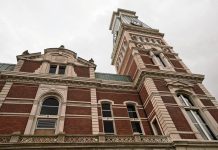The city’s champion of architecture believed there were two types of architects.
Monument builders who seek to glorify themselves through their work.
Problem solvers who seek to design buildings around the needs of the people who will use them.
To J. Irwin Miller, the late Cummins Inc. executive who brought Modern architecture to the city, monument builders had no place in Columbus.
[sc:text-divider text-divider-title=”Story continues below gallery” ]
Under Miller’s guidance, the distinctive buildings that gave Columbus its national reputation for architecture were instead designed to enhance the lives of the people in the community.
Jim Henderson, the retired Cummins chairman and chief executive officer who began his career in Columbus as Miller’s personal assistant, spoke about the impact Miller’s community-minded mentality had on the city’s architectural legacy during Wednesday’s annual meeting of the Columbus Indiana Architectural Archives.
“Irwin Miller is clearly the person responsible for the quality of architecture in Columbus,” Henderson said. “Without him, it just would not have happened.”
Miller’s insistence on community-centered design began with Columbus’ first significant piece of architecture, First Christian Church, completed in 1942.
Architect Eliel Saarinen was commissioned for the project, but he initially rejected the proposal because he feared the congregation would want the building to glorify themselves and not God.
That was exactly the mentality Miller and his extended family were looking for in a designer, Henderson said, so they worked to convince Saarinen that they shared his vision for a humble design.
“What they told him was, ‘We have a congregation here that values living a simple outward life but a rich one spiritually,” Henderson said. “He accepted.”
Finding focus
The First Christian Church project set the tone for Miller’s vision for the rest of the city’s architectural development, Henderson said. Buildings would be created not to benefit the designer but to help the people using the buildings do their jobs better, whether that job is to worship in a church or build engines in a factory.Because of that vision, Miller often commissioned burgeoning architects who had yet to develop a strong ego to complete projects around the city.However, when Cummins decided to develop Otter Creek Golf Course for the city, Miller sought out renowned golf course designer Robert Trent Jones Sr.
Although he was satisfied with Jones’ design, Miller’s concerns about working with a seasoned architect proved to be legitimate with Jones, Henderson said. The famous designer was commissioned to work all over the country, and he was not always as focused on his work at Otter Creek as Miller would have liked, he said.
But Miller found the focus he was looking for in Harry Weese, who was commissioned to design the Otter Creek clubhouse.
Like Saarinen with First Christian, Weese was dedicated to creating a building that served its patrons. In this case, that meant the clubhouse should revolve around the game of golf, a mentality evidenced by the all-glass walls that allow for a panoramic view of the course.
Additionally, Weese built the clubhouse with wood, glass and other natural materials that fit in well with the course’s natural landscape, another testament to his commitment to functional design.
‘Understanding the community’
Even more recent projects in Columbus completed near the end of Miller’s life — he died in 2004 — followed his community-centered philosophy.Steve Risting, an Indianapolis-based architect who is ending his second term as board president of the Columbus, Indiana Architectural Archives, was commissioned to build St. Bartholomew’s Catholic Church, a project that was completed in 2002.Creating the design for the church involved numerous meetings with church committee members, who at times asked him to completely start over and create a design that better suited the needs of their congregation. Although it was daunting and difficult to work in a city with such a rich architectural history, Risting said, Miller’s principle of seeking community input ultimately helped him to create a building that is beloved both for its beauty and its functionality.
“Success came from understanding the community,” Risting said.
As architectural development in Columbus begins to slow down, Henderson said the city should begin to shift its focus to architectural preservation, which also requires extensive community involvement. Public-private partnerships are the only way to save the city’s most renowned buildings, he said, which is why he has taken it upon himself to lead some of those partnerships.
The renovation of the new Hamilton Community Center & Ice Arena, for example, was completed in large part due to Henderson’s fundraising efforts.
While the city gave $1.6 million to the project, Henderson raised an additional $1.4 million, which was $400,000 more than he was asked to find.
Legacy of partnerships
Although some buildings that fall into disrepair might not be worth saving, Henderson said, he saw a future in the former ice rink, which is why he worked to ensure the facility would continue to operate.“It was very important, because there were some very unique aspects of that design,” Henderson said.However, without collaboration from both the city and its residents, Hamilton might not have been restored, Henderson said.
As Columbus’ most famous buildings continue to age, residents must realize that the city will not be able to preserve its architectural heritage without help from the public, he said.
“Columbus has this legacy of public-private partnerships, and that has done some amazing things for the community over time,” he said.
However, as the city looks toward preservation in the future, it is important to remember Miller’s vision of buildings that benefit the community, Henderson said.
The Hamilton Center had a future, but not without updating its services to better serve the needs of today’s Columbus residents.
Even though the actual buildings are no longer new, Henderson said, Miller’s emphasis on designs that serve the greater good stands the test of time.
“There is value in architecture, and that value is simple,” Risting said. “Architecture should serve the public.”
[sc:pullout-title pullout-title=”Pull Quote” ][sc:pullout-text-begin]
“Irwin is clearly the person responsible for the quality of architecture in Columbus. Without him, it just would not have happened.”
Jim Henderson, former Cummins Inc. CEO and personal assistant to J. Irwin Miller
[sc:pullout-text-end][sc:pullout-title pullout-title=”Miller’s 6 rules for architecture” ][sc:pullout-text-begin]
Although he said he could never count all of the things he learned from his time with J. Irwin Miller, Jim Henderson also said there are six main principles of architecture that Miller lived by that he now tries to apply to architecture in Columbus today:
- Work with problem solvers, not monument builders. Buildings should serve the people, not the architect.
- “Architect” means chief builder, not chief designer. Architects should physically work on the site of their projects to oversee progress.
- Be on the cutting edge, but not the edge. Architecture is about finding the balance between new ideas and ideas that actually work.
- Be a proactive and prepared client. Communicate your desires, because the building should speak to your needs.
- No one knows better how to do the job of a building than the people actually doing the job, so design for the people who will use the building.
- The devil is in the details, so pay attention.
[sc:pullout-text-end][sc:pullout-title pullout-title=”On the Web” ][sc:pullout-text-begin]
To learn more about Columbus’ architectural history or to schedule a tour, visit the Columbus Area Visitors Center at 506 Fifth St. or columbus.in.us. You can also learn more at columbus.in.us/columbus/art-architecture/architecture.
[sc:pullout-text-end][sc:pullout-title pullout-title=”Top 6 cities” ][sc:pullout-text-begin]
Columbus is included on the American Institute of Architects list of the top architecturally significant cities in the United States. Topping the list, in order:
- Chicago
- New York
- Boston
- San Francisco
- Washington
- Columbus
[sc:pullout-text-end]




